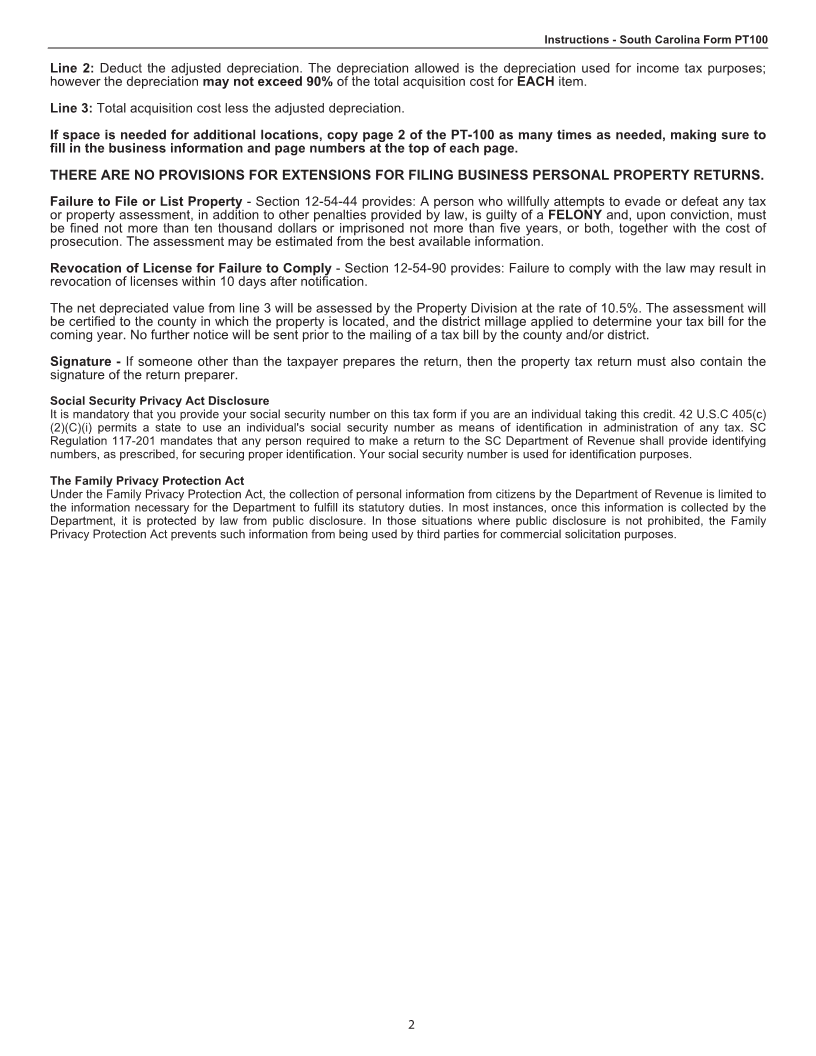
Enlarge image
PT-100 INSTRUCTIONS (Rev. 8/12/16)
Your Business Personal Property Return can be filed online for free at MyDORWAY.dor.sc.gov.
Business Personal Property Filing Requirements
Businesses are required to file on or before the last day of the fourth month after the close of the accounting period
regularly employed by the taxpayer for income tax purposes.
Any business which opens after the end of the accounting period must file an initial return as of December 31st with the
return being due the last day of April. After the initial return, businesses are required to file on or before the last day of
the fourth month after the close of the accounting period regularly employed by the taxpayer for income tax purposes.
PT-100 Instructions
Tax Year - This is the year after the Accounting Closing Period (i.e., if the Accounting Closing Period is 12/31/XXX1, the
Tax Year is reported as XXX2).
Accounting Closing Period - Please provide the business's accounting year-end. For changes to the accounting
closing period, provide the new accounting closing period and see the “Change in Accounting Closing Period” section
below.
File No. - A new Consolidated Business Personal Property (BPP) File Number has been assigned to all BPP Taxpayers.
When filing by paper, you must complete the file number section at the top of the form with the BPP File Number supplied
to you by SCDOR. This number is being mailed to each BPP Taxpayer.
Owner Name and Mailing Address - Provide the owner's name and mailing address in the sections provided. For
changes in mailing address see the “Reporting a Change of Address” section below.
Reporting a Change of Address To report a change of mailing address, enter the new mailing address in the mailing
address section and check the box “Check if this is a new address.”
Closing of Business - If the business is closed, please check the Final box under Account Status and provide the
business close date in the space provided. If you have more than one location and all of the locations did not close, do
not check the Final box and do not provide a close date.
Amended Return - If an Annual return has previously been filed for a tax year and the initial Annual return requires
changes, re-file the return and check the Amended box.
Changes in Accounting Closing Period - When there are changes to the business's accounting closing period, two
returns are required. A return is required to be filed at the end of both the prior accounting closing period and also the
new accounting closing period. When filing the return for the new accounting closing period, select the box “Return Due
to Changes to Accounting Closing Period.”
Location Reporting
Reference ID - Please provide the Reference ID for each location as assigned by the Department of Revenue. (Prior to
August 15, 2016 this was referred to as the location file number.) If this is a new location leave this space blank and a
Reference ID will be assigned when your return is processed. New Location Reference IDs will be mailed to the mailing
address on file and should be used for future filings.
Location Start Date - Provide the date this location opened.
Closing a Location - To close one or more locations, provide the close date for each location in the space “Location End
Date.” When closing a location, you must report a zero value in lines 1, 2 and 3 of the location.
Moving a Location - If you move the location of your business, close the old location and enter the new address for the
new location as a separate location on the return.
Reporting a Physical Location - All location addresses should be reported only once as a physical street address. PO
Boxes cannot be used as the location address.
Return Lines
Zeros have been pre-printed in the cents portion of the form to round to the nearest whole dollar. Values
reported for each location MUST be rounded to the nearest whole dollar.
Line 1: All costs associated with the acquisition of furniture, fixtures, and equipment that are used in the business,
EXCLUDING licensed vehicles.
1
